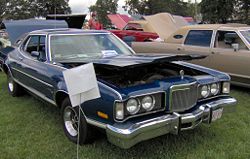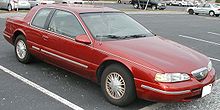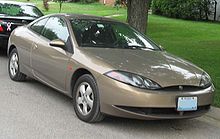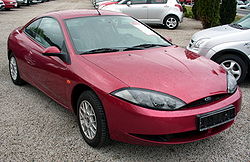- Mercury Cougar
-
Mercury Cougar 
1997 Mercury Cougar XR-7Manufacturer Ford Motor Company
AutoAlliance International
(1999–2002)Model years 1967–2002 Successor Mercury Marquis (sedan) Class Pony car (1967–1973)
Personal luxury car (1974–1997)
Sport compact (1999–2002)The Mercury Cougar is an automobile which was sold under the Mercury brand of the Ford Motor Company's Lincoln-Mercury Division from 1967 to 2002. The name was first used in 1967 and was carried by a diverse series of cars over the next three decades. As is common with Mercury vehicles, the Cougar shared basic platforms with Ford models. Originally this was the Mustang, but later versions of the Cougar were based on the Thunderbird, and the last was a version of the Contour/Mondeo. The Cougar was important to Mercury's image for many years, and advertising often identified its dealers as being "at the sign of the cat."[1] Female models holding big cats on leashes were used on Cougar ads in the early 1970s.[2] The car was assembled at the Dearborn Assembly Plant (DAP) (one of six plants within the Ford Rouge Center) in Dearborn, Michigan from 1967–73, at the San Jose Assembly Plant in Milpitas, California from 1968 into early 1969 and at the Lorain Assembly Plant (LAP) in Lorain, Ohio from 1974-97.
Contents
First generation (1967–1970)
First generation 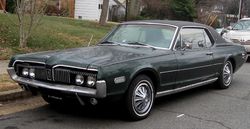
1968 Mercury Cougar XR-7Model years 1967–1970 Assembly United States: Dearborn, Michigan Body style 2-door hardtop coupe
2-door convertibleLayout FR layout Engine 289 cu in (4.7 L) Windsor V8
390 cu in (6.4 L) FE V8
302 cu in (4.9 L) Windsor V8
351 cu in (5.8 L) Windsor V8
428 cu in (7.0 L) FE V8
427 cu in (7.0 L) FE V8Wheelbase 111 in (2819 mm) Related Ford Mustang
The 1967 Cougar was based on that year's refaced first-generation Mustang,[3] but with a 3 inch (76 mm) longer wheelbase and new sheet metal. A full-width divided grille with hidden headlamps and vertical bars defined the front fascia—it was sometimes called the electric shaver grille. At the rear, a similar treatment saw the license plate surrounded on both sides with vertically slatted grillework concealing taillights (with sequential turn signals), a styling touch taken from the Thunderbird. A deliberate effort was made to give the car a more "European" flavor than the Mustang, at least to American buyers' eyes. Aside from the base model and the luxurious XR-7, only one trim package was available for either model: the sporty GT. The XR-7 model brought a wood-grained steering wheel, a simulated wood-grained dashboard with a full set of black-faced competition instruments and toggle switches, an overhead console, a T-type center automatic transmission shifter, and leather or vinyl seats. The GT package, meanwhile, supplied a much larger engine, Ford's 390 in³ (6.4 L) FE-series big block to replace the small-block 289 in³ (4.7 L) standard powerplant. Along with this came an upgraded suspension to handle the extra weight of the big engine and give better handling, more powerful brakes, better tires and a low-restriction exhaust system. The Cougar was Motor Trend magazine's Car of the Year for 1967.
The Cougar continued to be a Mustang twin for seven years, and could be optioned as a genuine muscle car. Nevertheless, it gradually tended to shift away from performance and toward luxury, evolving into something new in the market — a plush pony car. The signs were becoming clear as early as 1970, when a special edition styled by fashion designer Pauline Trigere appeared, complete with a houndstooth pattern vinyl roof and upholstery. A reskinning in 1971 saw the hidden headlights vanish for good, although hidden wipers were adopted. Between 1969 and 1973, Cougar convertibles were offered.
The introduction of the Cougar finally gave Mercury its own pony car. Slotted between the Ford Mustang and the Ford Thunderbird, the Cougar would be the performance icon and eventually the icon for the Mercury name for several decades. The Cougar was available in two models (base and XR-7) and only came in one body style (a two door hardtop). Engine choices ranged from the 200 hp (149 kW) 289 in³ 2-barrel V8 to the 335 hp (250 kW) 390 in³ 4-barrel V8. A notable performance package called the GT was available on both the base and XR-7 Cougars. This included the 390 in³ V8 as well as a performance handling package and other performance goodies.
Not much changed for the Cougar in its second year. The addition of federally mandated side marker lights was the major change, but the biggest changes were under the hood and in performance for the XR-7 model. A 210 hp (157 kW) 302 in³, 2-barrel V8 was the base engine on all XR-7s and early standard Cougars. Three new engines were added to the option list this year: the 230 hp (172 kW) 302 in³, 4-barrel V8; the 335 hp (250 kW) 428 in³, 4-barrel V8; and the 390 hp (291 kW) 427 in³, 4-barrel V8. In addition, the 289 in3 engine was made standard on base cars without the interior decor group mid way through the model year. Mercury was serious about the Cougar being the performance icon for the company. The XR-7G, named for Mercury road racer Dan Gurney, came with all sorts of performance add-ons, including a hood scoop, Lucas fog lamps and hood pins. Engine selection was limited only to the 302, 390, and 428 V8. A grand total of 619 XR-7Gs were produced, and only 14 G's were produced with the 428 CJ. The mid-year 7.0 L GT-E package was available on both the standard and XR-7 Cougars and came with the 427 V8. The 428 Cobra Jet Ram Air was available in limited numbers on the GT-E beginning 1 April 1968.[4] Conservatively rated at 335 hp (250 kW), the 428 Cobra Jet could produce much more (306 kW (410 hp)) from the factory. A grand total of 394 GT-Es were produced, 357 with the 427 and 37 with the 428.[5]
The third year of production, 1969, brought several new additions to the Cougar lineup. A convertible model was now available in either standard and XR-7 trim. These highly anticipated soft tops proved quite popular and today are considered, by many, among the most desirable of the '67-'70 production run. On the exterior, the grille switched from vertical bars to horizontal bars, and a spoiler and a Ram Air induction hood scoop were added as options. A new performance package appeared and several disappeared. The XR-7G and the 7.0 L GT-E disappeared, but the 390 and 428 V8s remained. The 290 hp (216 kW) 351 Windsor V8 was added to the engine lineup. The Eliminator performance package appeared for the first time. A 351 in3 4-barrel V8 was standard under the hood, with the 390 4-barrel V8, the 428CJ and the Boss 302 available as an option. The Eliminator was the new top of the line performance model of the Cougar lineup. It also featured a blacked-out grille, special side stripes, front and rear spoilers, an optional Ram Air induction system, and a more performance-tuned suspension and handling package. It also came in a variety of vibrant colors like White, Bright Blue Metallic, Competition Orange, and Bright Yellow. Only two Cougars came with the Boss 429 V8, making them the rarest Cougars ever built. Both were factory drag cars built for "Fast Eddie" Schartman & "Dyno" Don Nicholson.
The 1970, the Cougar appearance was similar to the 1969 model, however there were numerous changes inside and out. It now sported a new front end which featured a pronounced center hood extension and electric shaver grille similar to the 1967 and 1968 Cougars. Federally mandated locking steering columns appeared inside, and the aforementioned new nose and taillight bezels updated the look on the outside. The 300 hp (224 kW) 351 "Cleveland" V8 was now available for the first time, though both the Cleveland and Windsor engines were available, if the buyer selected the base model 2-barrel motor. The 390 FE engine was now dropped, and the Boss 302 and 428CJ soldiered on.
Total production: 1967: 150,893 1968: 113,720 1969: 100,060 1970: 72,343
Second generation (1971–1973)
Second generation 
1971 Mercury CougarModel years 1971–1973 Assembly United States: Dearborn, Michigan Body style 2-door coupe
2-door convertibleLayout FR layout Engine 351 cu in (5.8 L) Windsor V8
351 cu in (5.8 L) Cleveland V8
429 cu in (7.0 L) Super Cobra Jet V8.Wheelbase 112.0 in (2,845 mm) Related Ford Mustang For 1971, the Cougar was restyled, weighed less and had only a one-inch-longer wheelbase than its predecessors (112 vs. 111 - which was similar to GM's intermediate-sized two-door models such as the Olds Cutlass). The front end now featured four exposed headlights; the disappearing headlights were eliminated. The center grille piece was now larger. The rear featured a semi-fastback with a "flying buttress" sail-panel. The convertible returned, as did the XR-7 and the GT package. The Eliminator package was eliminated, but the Ram Air option remained. The engine lineup was revised for 1971 as well. Now only three engines were offered—the standard 240 hp (179 kW) 351 Windsor 2-barrel V8, the 285 hp (213 kW) 351 Cleveland 4-barrel V8 and the 370 hp (276 kW) 429 Super Cobra Jet 4-barrel V8.
By 1972, the climate had begun to change as the muscle car era ended. No longer able to use gross power numbers, the manufacturers had to use net power figures, which dropped the once mighty figures down substantially. Engines were shuffled around a bit. They were now the standard 163 hp (122 kW) 351 Cleveland 2-barrel V8, 262 hp (195 kW) 351 Cleveland 4-barrel V8, 266 hp (198 kW) 351 4-barrel Cobra Jet V8. Other than that, the Cougar remained a carryover from 1971. Only minor trim details were changed in 1972. The big blocks were gone for 1972 and 1973. The days of performance oriented muscle cars were coming to an end.
Aside from minor grille and taillight changes, 1973 would be largely a carryover year for the Cougar, but it would mark the last year of the Mustang-based Cougar, and the end of Cougar convertibles. Many changes were scheduled for the 1974 models. Power figures continued to change as new federal/EPA regulations began their stranglehold on the V8 engines. The new figures continued to fluctuate, but engine options remained unchanged from 1972. The standard engine continued to be the 168 hp (125 kW) 351 Cleveland 2-barrel V8. Optional was the 264 hp (197 kW) 351 Cobra Jet V8. The following years changed to the Thunderbird/Torino chassis.
Total Production: 1971: 62,864 1972: 53,702 1973: 60,628
Third generation (1974–1976)
Third generation
1976 Mercury Cougar XR-7Model years 1974–1976 Assembly United States: Lorain, Ohio Body style 2-door coupe Layout FR layout Engine 351 cu in (5.8 L) V8
400 cu in (6.6 L) V8
460 cu in (7.5 L) V8Wheelbase 114.0 in (2,896 mm) Related Ford Torino
Mercury MontegoFor 1974, the Cougar was shifted from its Mustang, ponycar origins onto a new platform and into a new market as a personal luxury car. It now shared a chassis with the larger Mercury Montego/Ford Torino intermediates and was twinned with the new Ford Elite. The wheelbase grew to 114 inches (2,896 mm) and became practically the only car to be upsized during the downsizing decade of the 1970s. These years marked the end of the "luxurious Mustang", and the beginning of the Cougar's move towards becoming a "junior Thunderbird" and eventually a sibling of the Thunderbird. TV commercials compared the Cougar to the Lincoln Continental Mark IV, the most notable featuring Farrah Fawcett in a 1975 TV ad.
The Cougar was being marketed as an intermediate-sized personal-luxury car to compete against GM's Chevrolet Monte Carlo and Pontiac Grand Prix. Every GM division had an entry in this market by 1974, and the market was too large to ignore. The new Cougar paid homage to its smaller predecessor with a three-piece grille up front, topped by a new hood ornament which featured the Jaguar-like silhouette of a creeping Cougar. The car's Montego heritage was fairly evident from the back, however. In between, it had acquired the sine qua non of the personal luxury car in the 1970s: opera windows. This body ran unchanged for three years, and during this period all Cougars were XR-7s.
The Cougar was also restyled inside due to the switch to the larger intermediate body, but maintained the front fascia look from 1973 with a new styling feature including a rectangular opera window in the rear C-pillars. The Cougar also began to share the look of the Thunderbird and Continental Mark IV as the years progressed. The base model and convertible were dropped this year, but the XR-7 moniker soldiered on as the only model in the Cougar lineup.
Engine offerings from 1974 to 1976 included a standard 351 in³ V8 and optional power plants included the very rare Q-code 351 "Cobra Jet" V8(1974), plus 400 and 460 in³ V8s. The manual transmission was dropped in favor of the automatic.
Interior offerings during these three years included a standard bench seat with cloth or vinyl upholstery, an optional Twin-Comfort Lounge 60/40 bench seat with center armrest and cloth, vinyl or optional leather trim; or all-vinyl bucket seats with center console.
In 1975, the Cougar XR-7 continued to add more luxury features as it moved upscale. But with more features, the Cougar was gaining in weight as well. Compared to the 1967 version, the 1975 version weighed a full 1,000 lb (450 kg) more. Despite the added weight, the buying public wanted the Cougar and sales figures reflected that fact. For the performance fans, however, a high-performance rear axle and Traction-Lok differential continued to be on the option sheet. The standard engine continued to be the 148 hp (110 kW) 351 Windsor 2-barrel V8 with the 158 hp (118 kW) 400 2-barrel V8 and 216 hp (161 kW) 460 4-barrel V8 optional.
The 1976 Cougar entered its last year largely unchanged from 1975. There was a new body for the Cougar in 1977, so nothing else major was done to the Cougar. Only some minor trim pieces served to differentiate this year from last. Engines continued unchanged as well. The high performance axle and Traction-Lok differential were dropped this year. Twin Comfort Lounge reclining seats, with or without velour cloth trim, were the only major change for the interior, but it also showed how much the performance aspect of the Cougar had disappeared.
Total Production: 1974: 91,670 1975: 62,987 1976: 83,765
Fourth generation (1977–1979)
Fourth generation 
1977–79 Mercury CougarModel years 1977–1979 Assembly United States: Lorain, Ohio Body style 4-door sedan
4-door station wagon
2-door coupeLayout FR layout Engine 302 cu in (4.9 L) V8
351 cu in (5.8 L) V8
400 cu in (6.6 L) V8Transmission C4 automatic
FMX automatic
C6 automaticWheelbase 114.0 in (2,896 mm) Related Ford LTD II
Ford ThunderbirdIn 1977, radical marketing changes came to Ford's intermediate lineup, although under the skin, mechanical changes were few. The Montego name was discontinued, and all the intermediate Mercury vehicles became Cougars (Ford renamed its Torino line the LTD II). There were now Cougar sedans, complete with opera windows, a lower-line base coupe, and even a station wagon (Cougar Villager), which lasted only one year (1977). The top-of-the-line XR-7 continued as a separate model, with unusual simulated louvers applied in front of its opera windows and a new rear style that was meant to evoke the larger Lincoln Mark coupe. This year, the Elite name vanished from the Ford lineup and the Thunderbird was downsized onto its chassis to become the XR-7's corporate twin. This association between the two cars would continue for two decades. In keeping with the general trend of the times, the old Torino chassis was discontinued after 1979 and all Ford and Mercury intermediates went over to the smaller, lighter Ford Fox platform for 1980.
Customers to Lincoln-Mercury showrooms were surprised by the all-new Cougar this year. New sharper and straighter styling that mimicked the Ford Thunderbird and Lincoln Continental Mark V replaced the "fuselage look" of earlier Cougars. The Cougar now shared its body with the Thunderbird, which was downsized to the intermediate bodyshell this year from that of the Continental Mark IV and shared the Cougar's 114-inch (2,896 mm) wheelbase, putting the T-Bird squarely in the intermediate personal-luxury car market as opposed to its previous higher-priced segment of that market shared with the Buick Riviera and Oldsmobile Toronado. This move would join the Thunderbird and Cougar together and would last until their demise in 1997. The lineup was also expanded to include a sedan and station wagon. This was because the Mercury Montego had been discontinued and its models were absorbed into the Cougar lineup as a result while Ford Division renamed the Torino as LTD II. The base Cougar returned as well for all three models. But the XR-7 came only as a coupe. The Cougar Brougham was available as a coupe or sedan, and the Cougar Villager was available as a station wagon only. The engine lineup changed for this year as well. The base engine was the 134 hp (100 kW) 302 2-barrel V8 on all coupes and sedans. The station wagons had the 161 hp (120 kW) 351 2-barrel V8 standard. The 149 hp (111 kW) 351 2-barrel V8 and 173 hp (129 kW) 400 2-barrel V8 were optional on all models.
For 1978, the base model 2 door (Model #91 and Body Style 65D) and 4 door (Model #92 and Body Style 53D) hard top sedan stayed the same. The Brougham was discontinued as a separate model and became an option package on the base Cougar. The base model started at $5,009.
XR-7 (sport-luxury package) sales continued to skyrocket. This package (Model #93 and Body Style 65L) was only available in a 2 door hard top coupe. This model included power brakes/steering, 15 inch wheels, rear stabilizer bar, walnut woodtone instrument pannel, "XR-7" trunk key-hole door, "COUGAR" decklid script, large hood ornament, and sport-styled roofline with back half vinyl and rear opera side windows/louvers. Some XR-7s had the Rally Sport Tach and Gauge package (only 25% of all Cougars came with this option). XR-7 models started at $5,603.
Two new decor packages became available, the XR-7 Decor Option and the Midnight/Chamois Decor Option. This latter package came with a half-vinyl roof, padded "Continental" type rear deck, and Midnight Blue and Chamois interior with Tiffany carpeting. This was Mercury's take on the special designer decor options used in the Lincoln Continental Mark VI. Engines continued unchanged as well. The Cougar XR-7 would set an all time sales record this year.
Few changes were made in 1979, as Mercury prepared to downsize the car. A new electronic voltage regulator and a plastic battery tray would be the biggest mechanical changes for the Cougar. The standard engine continued to be the 302 V8 with the 351 the only optional engine available, as the 400 was discontinued. A redesigned grille with body color inserts and a revised taillight assembly were the only exterior body changes.
Total Production: 1977: 194,823 (XR-7 124,799) 1978:213,270 (XR-7 166,508) 1979: 172,152 (XR-7 163,716)
Fifth generation (1980–1982)
Fifth generation 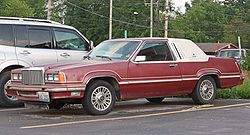
1980–82 Mercury Cougar XR-7Model years 1980–1982 Assembly United States: Lorain, Ohio Body style 2-door coupe
4-door sedan
4-door station wagonLayout FR layout Platform Ford Fox platform Engine 255 cu in (4.2 L) Windsor V8
302 cu in (4.9 L) Windsor V8
140 cu in (2.3 L) Lima I4
232 cu in (3.8 L) Essex V6Transmission 5-speed Tremec T-5 manual
3-speed C5 automatic
4-speed AOD automaticWheelbase 104 in (254 cm) Related Ford Thunderbird
Ford Fairmont
Ford Granada
Mercury ZephyrFor 1980, the Cougar was downsized to the 108-inch (2,700 mm) wheelbase Fox platform, shared with the Zephyr. The sedan and base coupe were dropped, leaving only the XR-7. Opera windows became optional, although the louvered style of the old opera windows was applied to the standard-window coupes. Wipers were no longer hidden, and for the first time, the Cougar had sedan frames around its windows. Inside, there was a turn to flashy electronics, considered ultramodern at the time, with digital instrumentation and trip computer functions available. A smaller 119 hp (89 kW) 255 in³ (4.2 L) V8 was the base engine, but this engine was considered weak and did not last long, and the 134 hp (100 kW) 302 V8 was optional along with a newly introduced four-speed automatic overdrive transmission. Like the downsized Thunderbird, this generation was poorly received by the public.
In 1981 the return of the base Cougar along with a sedan greeted Cougar buyers; the sedan replaced the Mercury Monarch. The engine lineup grew as a 94 hp (70 kW) 200 in³ I6 became the standard engine in the XR-7 and an 88 hp (66 kW) 140 in³ I4 became the standard engine on the base Cougar, bringing with it a manual transmission. This marked the first time that a four-cylinder engine was available on the Cougar as well as the first time the XR-7 didn't feature a standard V8. Appearance carried over as well, but two new trim lines were added to the Cougars—GS and LS. Both packages were similar in both models, but the base Cougar's LS package only came on the sedan. The GS package focused on appearance, while the LS package offered luxury touches such as power windows and other luxury trim touches.
The Cougar lineup continued to expand in 1982 as the station wagon returned for another single-year appearance in the Cougar lineup. It was available in GS or Villager trim lines. The Villager trim added faux rosewood body side appliqué. Another engine was added, the all-new 112 hp (84 kW) 232 in³ V6, but the XR-7 line's 302 V8, was dropped. The GS and LS trim lines continued to be optional on both Cougar models.
Total Production: 1980: 58,028 1981: 90,928 1982: 73,817
Sixth generation (1983–1988)
Sixth generation 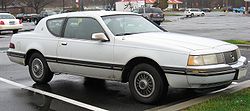
1987–88 Cougar LSModel years 1983–1988 Assembly United States: Lorain, Ohio Body style 2-door coupe Layout FR layout Platform Ford Fox platform Engine 4.9 L (302 cu in) 5.0 Windsor V8
3.8 L (232 cu in) Essex V6
2.3 L (140 cu in) Lima I4 turboTransmission 5-speed Tremec T-5 manual
3-speed C5 automatic
4-speed AOD automaticWheelbase 104 in (254 cm) (1980–86)
104.2 in (265 cm) (1987–88)Length 197.6 in (502 cm) (1983–86)
200.8 in (510 cm) (1987–88)Width 71.1 in (181 cm) (1983–86)
70.1 (178 cm) (1987–88)Height 53.4 in (136 cm) (1983–86)
53.8 in (137 cm) (1987–88)Curb weight 3050-3500 lb (1400-1600 kg) Related Lincoln Continental
Ford LTD
Ford Thunderbird
Ford Fairmont
Mercury Marquis
Ford Granada
Mercury ZephyrAn all-new Cougar greeted buyers in 1983; gone were the sedan and station wagon models which were facelifted and moved under the Marquis nameplate. The Cougar sported a completely new aerodynamic body, but retained the same chassis. This restyle was shared with its sister car, the Thunderbird, with the two becoming the first examples of the new "aero-look" design, which would eventually spread throughout the Ford line and ultimately the entire industry. The major difference between the two was the side window treatments; the Cougar had a more formal notchback with a nearly vertical rear window and upswept quarter windows. This made the Cougar look more aerodynamic as well as more exciting when compared to previous Cougars. The new look was such a hit that it outsold the Thunderbird for 1983. But due to the amount of money spent in restyling both models, the interiors were left mostly unchanged from 1982. The GS (but not badged as such) and LS models carried over from the previous year; however, the XR-7 did not as there was not yet a performance version ready. The engine lineup changed, as the only two engines offered were the 232 in³ (3.8 L) V6 and the 302 in³ (5.0 L) V8. 390mm (15.3") TRX wheels were an option.[citation needed]
After its redesign in 1983, the Cougar remained mostly unchanged for 1984. The XR-7 returned and for the first time, its standard engine was not a V8 or V6, but a turbocharged four-cylinder engine. Similar to the Thunderbird Turbo Coupe, the XR-7 came only with the 145 hp (108 kW) 140 in³ turbocharged I4. The XR-7 also featured blacked-out window trim, wide body side mouldings and two-tone paint in silver with charcoal grey lower (or the reverse combination) with tri-band striping to separate it from the base Cougars. A performance suspension was also standard. A three-speed automatic or a five-speed manual were offered on the XR-7. Also for 1984, the 3.8 L V6 switched from a carburetor to throttle-body fuel injection.
Subtle exterior changes, such as a new Mercedes-Benz-esque grille and new taillights were just a few of the many changes as a whole new interior greeted buyers for 1985. This new interior featured a digital instrument cluster which lent a futuristic touch to the Cougar, but it was only available on base Cougars.
The 1986 Cougar was a carryover year; it was supposed to be redesigned this year, but with sales continuing to be strong, Ford decided to push it ahead to 1987. The biggest changes were under the hood, as the 302 V8 received new sequential electronic fuel injection (SEFI), which boosted power to 150 hp (112 kW); a 30 hp (22 kW) improvement over the previous year. The Cougar XR-7 continued to offer only the turbocharged I4, but it got a power increase to 155 hp (116 kW).
Total Production 1983: 75,743 1984: 131,190 1985: 117,274 1986: 135,904
1987–1988
The Cougar received a complete restyle for its 20th anniversary. Much smoother than the previous Cougar, it featured flush-mounted headlights and grille. The side quarter glass retained its upswept design, but it was stretched more to the rear of the car. The interior remained mostly unchanged. The GS was dropped, leaving the LS and XR-7 models. The XR-7 changed by dropping the turbocharged I4, and the 302 V8 became the standard engine. The manual transmission was also dropped this year. The digital instrument cluster, previously optional on the GS/LS models, became standard with exception to the limited edition XR-7, which became analog only. The special lower tri-stripes and blacked out window trim continued to set apart the XR-7 from the LS. The Cougar's 20th anniversary was highlighted by a limited-edition Cougar.
Total Production: 1987: 105,847 1988: 113,801
20th Anniversary Cougar
To celebrate its twentieth anniversary, a limited edition Cougar was produced. The car went on sale in February 1987. The Cougar LS was the starting point for this special model. These special Cougars featured these standard items to set them apart from the regular production Cougars:
- Cabernet Red exterior w/Midnight Smoke moldings
- All exterior badging (front bumper, grille trim, trunk lid nomenclature and moulding trim) was finished in 24 karat gold. C-pillar emblems were finished in a gold cloisonné.
- Nonfunctional luggage rack
- Mustang GT wheels painted gold with a Cougar center cap
- Special "20th Anniversary Edition" dash emblem
- Light Sand Beige interior with unique part-leather, part-suede Ultrasuede seats with heating and three-user memory profile. The seats also featured a special Cabernet Red piping.
- Special embroidered 20th Anniversary floor mats
- Traveler's convenience kit
- A hardcover book - "Mercury Cougar 1967–1987", which detailed the history of the Cougar
- 150 hp (112 kW) SEFI 302 V8
- Sport handling suspension package (XR-7)
The only options were power moonroof, power antenna, illuminated entry, keyless entry, automatic climate control, engine block heater, and a Traction-Lok axle with a 3.08 gear ratio. Total Production of 20th anniversary Cougar was 5,002, with at least 800 destined for Canada.
With the new MN-12 chassis and new body style coming in 1989, the 1988 Cougar changed little from the previous year. Outside, the biggest change was that the XR-7 now came in a new monochromatic color scheme. It was available in three colors (black, red, and white) with body colored or optional argent color wheels. The base 232 in³ (3.8 L) V6 was revamped to include multi-port fuel injection and an internal balance shaft that increased power to 150 hp (112 kW). The 302 V8 received a dual exhaust option, which added 5 hp (4 kW). The analog gauge cluster returned as standard on the XR-7, but the digital cluster remained as an option on both the LS and XR-7.
Seventh generation (1989–1997)
Seventh generation
1989–90 Mercury Cougar LSModel years 1989–1997 Assembly United States: Lorain, Ohio Body style 2-door coupe Layout FR layout Platform Ford MN12 platform Engine 3.8 L Essex V6 (1989–1997)
5.0 L Windsor V8 (1991–93)
4.6 L Modular V8 (1994–97)Transmission 4-speed AOD or 4R70W automatic
5-speed manual M5R2(1989–90)Wheelbase 113.0 in (2,870 mm) Length 1989–1991: 198.7 in (5,047 mm)
1992–94: 199.9 in (5,077 mm)
1995–97: 200.3 in (5,088 mm)Width 1989–1994: 72.7 in (1,847 mm)
1995–97: 73.1 in (1,857 mm)Height 1989–1991: 52.7 in (1,339 mm)
1992–97: 52.5 in (1,334 mm)Curb weight 3528 lb (1600 kg) with V6
3666 lb (1663 kg) with V8Related Ford Thunderbird The Cougar entered its seventh generation with a completely new body and chassis. Nothing carried over from the previous Cougar except for badging and the engine. In fact, only six parts were carried over from 1988. The biggest change was the switch to the larger MN12 chassis which was shared with the Ford Thunderbird. The chassis featured a fully independent rear suspension, a first for the Cougar. It was also nine inches (229 mm) longer (104.2" vs. 113") for better rear leg room. The flowing lines and extreme notchback roofline were still there, but this generation integrated the two much more successfully. To the surprise of fans, the car had no V8 engine available when introduced. Instead, the base LS had a naturally aspirated 140 hp (104 kW) 3.8 L V6, backed by a 4 speed automatic transmission which had a hard time moving the nearly 3,800 lb (1,700 kg) Cougar.
The XR-7 had a 210 hp (157 kW) supercharged version of the same engine, the car could be equipped with a 5-speed manual transmission or a 4-speed automatic with overdrive. Mercury spared no expense in making the XR-7 the performance model; giving it 4 wheel anti-lock disc brakes, an electronically adjustable sport-tuned suspension, monochromatic paint scheme in red, white, and black, and 16" wheels. The LS being more luxury oriented featured a fully digital instrument cluster and chrome trim on the outside.
The Cougar saw a minor facelift for 1991, with a smaller grille and slight changes to the headlights, taillights, and side trim.
The supercharged engine did not find favor with buyers, and the 200 hp (149 kW) 5.0 L V8 came back to replace it in 1991. As before, it was standard in XR-7s and optional in LS models. A special edition was built in 1992 to commemorate the 25th anniversary of the Cougar.
In 1993 the LS disappeared and the XR-7 nomenclature was changed to XR7 and became the only model available, it was equipped much like the LS except for the leather wrapped wheel/shifter and full analog gauge cluster.
The 1994 Cougar received an all new interior, updated tail lights, grille, body side molding, and the AOD transmission was replaced by the 4R70W in both the V6 and V8 versions of the car. Ford's new OHC 205 hp (153 kW) 4.6L V8 replaced the old OHV 302 as the optional engine.
For the 1996 model year, the exterior was given a significant facelift. The front and rear bumper covers, headlights, grille, and moulding were updated, giving the car a more modern look. The 4.6 L engine received an updated intake manifold, giving the car 15 lb·ft (20 N·m) of additional torque over the 1995 model, and the transmission was revised for increased reliability. In 1997, Ford began cutting corners in convenience items, such as the removal of the underhood light and the glove box light. The interior was updated, including a revised instrument cluster, much like that of the Ford Taurus/Mercury Sable, a console with cupholders was included for the first time. The ashtray and cigarette lighter were relocated to the space previously occupied by the information center, below the HVAC controls. Another anniversary edition car was built to celebrate 30 years. This was the last year for the MN12 Cougar, as Ford ultimately decided to discontinue its trio of personal luxury cars: the Mark VIII, the Cougar, and the Thunderbird to concentrate on production of high-profit SUVs.
Total Production: 1989: 97,246 1990: 76,467 1991: 60,564 1992: 46,982 1993: 79,700 1994: 71,026 1995: 60,201 1996: 38,929 1997: 35,267
Eighth generation (1999–2002)
Eighth generation 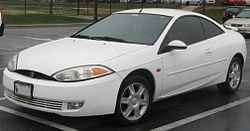
2001-2002 Mercury CougarManufacturer Ford Motor Company Also called Ford Cougar (Europe) Model years 1999–2002 Assembly United States: Flat Rock, Michigan Class Sport compact Body style 2-door coupe Layout FF layout Platform Ford CDW27 platform Engine 2.0 L Zetec I4
2.5 L Duratec V6Transmission 5-speed MTX-75 manual
4-speed CD4E automaticWheelbase 106.4 in (2700 mm) Length 185.0 in (4700 mm) Width 69.6 in (1770 mm) Height 52.2 in (1330 mm) Curb weight 2892 lb (1312 kg) Related Ford Contour
Ford Mondeo
Mercury MystiqueThroughout the early 1990s, sales of large personal luxury coupes were declining. At the same time, small subcompact sport coupes, mainly from Japan, were growing in popularity with younger buyers; this prompted Ford to redesign the Cougar. Of the three names that had constituted Ford's personal luxury lineup, Mark, Thunderbird, and Cougar, the Cougar returned first and was based on the Ford Contour sedan. Launched in the UK at the British Grand Prix at the Silverstone Circuit in 1998,[6] this Cougar became Mercury's first sport compact since the 1983 Mercury LN7.
This generation of Cougar had a far more contemporary package, with modern DOHC 24-valve 6 cylinder Duratec engines, a fully independent multilink suspension, and front-wheel drive. This was also the first hatchback Cougar, and the first to have its own body, unshared by any Ford (except its European twin Ford Cougar). The body design used a philosophy Ford dubbed "New Edge" design: a combination of organic upper body lines with sharp, concave creases in the lower areas. The Cougar's body, and the New Edge idea in general, was introduced as a concept called the Mercury MC2 in 1997, and was considered a bigger version of the European Ford Puma.
The 1999–2002 Cougars were available with two engine options, the 2.0 L Zetec 4-cylinder engine with 125 hp (93 kW; 127 PS), and the 2.5 L Duratec V6 with 170 hp (127 kW; 172 PS). Also, two transaxle options were available: the manual Ford MTX-75 transmission or the automatic Ford CD4E transmission (available in the U.S. with either engine, although the I4/automatic combination was extremely rare; supposedly only 500 Cougars were built with the I4/auto).
"Sport Package" models of the V6 featured 4-wheel vented disc brakes (from the Contour SVT), 16" alloy wheels, and the speed governor removed. With the electronic speed limiter removed, the top speed of the car was limited by drag and engine power in top gear at redline, around 135 mph (217 km/h).[citation needed] While this was considered attainable given enough road, the automatic transmission version could not reach this speed without significant engine modification. Without the sport package, the speed governor was set at 115 mph (185 km/h) due to the H-rated tires with which the car was equipped.
Ford also prepared two high performance concept-only versions dubbed the "Eliminator", which was a supercharged version built with aftermarket available parts, and the "Cougar S", which featured new body work, all wheel drive and a 3.0 L Duratec engine.
Ford also sold this generation of Cougar in Europe and Australia as the Ford Cougar, but it was not a sales success.
This new generation was aimed at younger buyers, but was sold alongside Sables and Grand Marquis which were marketed toward middle aged buyers. Also, Mercury salesmen did not know how to properly market the car, as they were used to interacting with older customers.[citation needed]
A high-performance Cougar S (not to be confused with the concept) was discussed in the press, which was essentially a Cougar with a Contour SVT engine; however, this version never made it into production. The Cougar S was so close to production however that many of its parts are still available to order from the dealership and it is listed in many parts catalogs and insurance databases.[citation needed] It was also to be sold in Europe as the Ford Cougar ST200.
To help create excitement for the Cougar, Mercury created several paint and trim packages:
- Special Edition (2000 model year) available in Zinc Yellow, leather interior with yellow stitching on the seats
- C2 (2001-2002 model years) available in either French Blue, Silver Frost, or Vibrant White, along with special blue interior accents
- Zn (2001 model year) available with special Zinc Yellow, special Visteon hood scoop and spoiler
- XR (2002 model year) available in either Black or XR Racing Red, with special black and red seats and interior trim. Also came with 17" silver wheels with black accents on the inner spokes.
- 35th Anniversary (2002 model year) Available in Laser Red, Satin Silver, and Black. Most came with leather interiors with silver center sections on the seats. They also came with 17" machined wheels, the same as the XRs without the black paint on the center spokes
- Roush Edition (1999-2000 model year) Available mostly in white and silver color choices, this car was built under the Roush name with body work done to the front bumper, back, side skirts and more. It is considered the rarest of all Cougars, since only 112 were ever made during its 2-year production.
For the 2001 model year, the Cougar was "updated" as the Cougar2 with new headlights, front and rear fascias, and updated interior trim.
Ford announced a restructuring plan in 2002, and the Cougar was cancelled for good (along with the Ford Escort, Lincoln Continental and Mercury Villager). The discontinuation of the Cougar left no four-cylinder vehicles in the Mercury lineup until the 2005 Mariner SUV arrived.
US production numbers
Calendar Year 1999 88,288 2000 44,935 2001 25,044 2002 18,321 Ford Cougar (Europe)
Main article: Ford Cougar (Europe)The Ford Cougar is a mid-sized coupé sold in the European market between 1999 and 2002. The car was named after the Mercury vehicle. It was originally intended to be the third generation Probe, but after a rationalisation of the three coupés available in the USA, the Probe name was dropped in favour of the Cougar. It is identical to the US Mercury version, except for badging and right-hand-drive in the UK only.
Racing
In 1967, renowned NASCAR race car builder Bud Moore campaigned Mercury Cougars in the Trans-Am Series with Ford Motor Company factory support. The team featured super star caliber drivers such as Captain Dan Gurney, Parnelli Jones, Peter Revson, David Pearson and Ed Leslie. Factory support dried up towards the end of the season and the Cougars began to show their wear. Ultimately Mercury lost the championship to Ford by two points.[8]
In 1968, Bud Moore took his Cougars NASCAR racing in the newly formed Grand American series. Star driver Tiny Lund dominated the series and took the championship.
After the Cougar changed to the Thunderbird platform in 1974 the bodystyle was raced in NASCAR. The Wood Brothers Racing team with David Pearson and then later Neil Bonnett was very successful with the car and scored a number of victories until the bodystyle became ineligible following the 1980 season. The next year (1981) saw the previous Cougar teams switch to the Thunderbird when NASCAR mandated the smaller (110" wheel based) cars, though oddly the Thunderbirds had to have their wheel bases streched 6", as the production cars wheelbase was only 104". From 1989 to 1990, Lincoln-Mercury Motorsport fielded Cougars of the new body style in the GTO class of the IMSA GT Championship. The cars collected the championship both years, and continued the teams' streak to 7 manufacturer's championships.
References
- ^ The Sign of the Cat
- ^ TCCN II - Feature Articles > Cougar Ad Gallery
- ^ Ford Motor Company - Featured Story - Fords Past, Present and Future Come to Carlisle
- ^ Guide to Muscle Cars Magazine, 6/87, p.79.
- ^ Cougar Club of America production statistics courtesy of Marti Auto Works
- ^ "About the Ford Cougar". The Ford Cougar Owners Club. http://www.ukcougar.com/about_the_cougar.htm.
- ^ "99-02 Mercury Cougar production numbers". NewCougar.org. 2004-10-18. http://www.newcougar.org/forums/general-info/73053-cougar-production-numbers-2.html. Retrieved 2011-09-04.
- ^ 1967 Trans-Am Scores at www.trans-amseries.com Retrieved on 5 September 2010
External links
Mercury, a division of Ford Motor Company, 1939–2011 Category · Vehicles Final models
(2010-2011)Historic models Bobcat · Brougham · Capri · Colony Park · Comet · Commuter · Custom · Cougar · Cyclone · Eight · LN7 · Lynx · M-Series · Marauder · Marquis · Medalist · Meteor · Monarch · Montclair · Montego · Monterey (car) · Monterey (mini-van) · Mystique · Park Lane Brougham · S-55 · Sable · Topaz · Tracer · Turnpike Cruiser · Villager · Voyager · ZephyrConcept cars « previous – Mercury passenger vehicle timeline, 1980–2011 Type 1980s 1990s 2000s 2010s 0 1 2 3 4 5 6 7 8 9 0 1 2 3 4 5 6 7 8 9 0 1 2 3 4 5 6 7 8 9 0 1 Subcompact Bobcat Lynx Tracer Compact Tracer Tracer Zephyr Topaz Topaz Mystique Mid-size Monarch Marquis Sable Sable Sable Sable Milan Full-size Marquis Grand Marquis Grand Marquis Grand Marquis Grand Marquis Colony Park Marauder Montego Sable Sport compact Capri Capri LN7 Cougar Personal Cougar Cougar Cougar SUV Mariner Mariner Mountaineer Mountaineer Mountaineer Minivan Villager Villager Monterey Categories:- Mercury vehicles
- Coupes
- Hatchbacks
- Sedans
- Station wagons
- Mid-size cars
- Sports cars
- Sport compact cars
- Muscle cars
- Front wheel drive vehicles
- Front wheel drive sports cars
- Rear wheel drive vehicles
- 1960s automobiles
- 1970s automobiles
- 1980s automobiles
- 1990s automobiles
- 2000s automobiles
- Vehicles introduced in 1967
Wikimedia Foundation. 2010.



